Notes for ‘s Tyldum’s Passengers (2016)

The Avalon absorbs meteoroid
Tyldum, M. (Director). (2016). Passengers. Written by Jon Spaiths. USA: Columbia Pictures.
- A short summary of the film
- Themes, motifs and mise-en-scene
- Discussions of the film
- Relevance to focus questions
- Resource list
A short summary of the film
- Passengers (Tyldum, 2016) opens with a familiar scene of the approach of a long, sleek spaceship powered by the blue haze of energy propelling it forward. The Avalon is unusual in its rotating leaves around a long axis, noted by Davis (2016) as one of the most beautiful of all starships with its sycamore-seed design.
- Leading the Avalon is a force field that glows orange-red when interstellar particles strike and are absorbed into the field. The view of the Avalon from an approaching field of micro and larger meteoroids shows the sparky field as a bowsprit absorbing incredible impacts but the point-of-view warns of an approaching impact the Avalon cannot absorb as easily. The impact displays red alarms on a holographic display in the control room, leaving one persistent error, one pod amongst 5000 travelling in stasis in the vast Avalon.

The Avalon’s passengers in stasis pods
- James Preston, a Mechanical Engineer, is awakened by the error (Tyldum, 2016, 04:07) and staggers blearily to a bland little cabin allocated to him by the holographic host computer.
- The next morning James, who says he is Jim, joins Learning Group 38 (Tyldum, 2016, 07:34) where he is lectured by a holographic female officer of the Homestead Company but Jim protests he is alone. The holograph continues with a the short talk about the journey to Homestead II, where all the colonists and crew are heading. But Jim finds no-one else awake and the ship computer system is not intelligent enough to help him, or even believe he is awake at the wrong time.
- Jim makes his way to a simulation room, the Observatory, where the computer system demonstrates that the Avalon has travelled for 30 years but still has another 90 years of travel ahead. Jim sends a message about the error back to Earth but hears the message will take 19 years to arrive and many more years for an answer (Tyldum, 2016, 11:09).

Jim is shown the Avalon’s flight to his awakening
- In despair, Jim roams the ship trying to break into the command centre where the flight crew are also in stasis. He passes a bar in the entertainment area of the Avalon and sees a bartender but learns this is an android, Arthur (Tyldum, 2016, 13:10), as the sound track plays Frank Sinatra singing ‘Call me Irresponsible’, hinting at a major theme of the film.
- Further malfunctions occur due to the original collision with the meteoroid (Tyldum, 2016, 17:35) and Jim uses a crowbar to move into a much better room, the Vienna Suite, following Android Arthur’s advice to “live a little” (Tyldum, 2016, 19:09).
- Jim manages to convince restaurant robots to serve him food and drink, even though he has a low rank onboard. He begins to look ragged and hopeless, like someone wrecked on a deserted island, even though he lives in luxury and plays interactive games with onboard simulations (Tyldum, 2016, 20:03).

Android Arthur serving at the excellent Avalon bar
- Jim walks through the sleepers in their pods and hurls an empty bottle he drank amongst the pods. He finds a space suit said to be incredibly strong and flexible and with a tether attached he steps away from the ship into the circling vista of stars (Tyldum, 2016, 22:25). He takes off the suit but then steps back into the airlock without the suit, apparently intending to kill himself (Tyldum, 2016, 24:31). But he runs back and slips on the bottle he threw earlier.
- Jim pulls himself up and looks at the young woman in the pod where he fell (Tyldum, 2016, 25:18). He becomes obsessed with the traveller, Aurora Lane, and Jim researches everything about her (Tyldum, 2016, 26:34). It is clear that Jim is becoming increasingly involved with Aurora through her filed recordings and he confides with Arthur that he wants to awaken Aurora from her pod. Jim works out punching a bag and then shaves, looking into the mirror and saying to himself “Please don’t do it” (Tyldum, 2016, 30:11) but thirty seconds later he triggers the pod to open and awakens Aurora.

Image of a disheveled Jim in despair
- After Aurora cleans herself up and starts to explore the Avalon Jim pretends to meet her for the first time. He explains that the pod cannot be reused (Tyldum, 2016, 35:42) and she cannot return . Like him, she is stuck on the ship and will die on the ship.
- Jim confides to Android Arthur that he must never tell Aurora the truth, that he has awakened her ((Tyldum, 2016, 37:38). There are further glitches with the Avalon’s controls and a robot smashes itself against a wall (Tyldum, 2016, 40:29). Meanwhile, Aurora has recovered from her shock and is writing, dictating into a writing device. This turns into a montage of the passing of time, leading to Aurora swimming in the Universe Pool, a pool encased in glass that reaches out of the ships body and looks as if she is swimming amongst the stars (Tyldum, 2016, 41:37). As she is a writer from a family of writers, Aurora interviews Jim about his “ultimate geographical suicide” by emigrating to Homestead II (Tyldum, 2016, 42:36) and admits that she has a return ticket so she would “Fly to Homestead II, live for a year and right back to Earth.” (Tyldum, 2016, 45:09) Earth would have moved forward 250 years and Aurora will chronicle “humanity’s flight to the stars” (Tyldum, 2016, 45:38).
- There is another montage showing time passing and Aurora drawing closer to Jim and at the end of a night Aurora leaves the bar and Arthur winks at Jim and says “she is an excellent choice” (Tyldum, 2016, 48:08) and Jim looks guilty and worried. To show his devotion Jim makes Aurora a model of an Art Deco building, in the style of the images in the bar. We see Aurora swimming again with Jim watching and with a background of romantic music, Jim uses a cleaning robot to deliver Aurora a note to ask her for a date. They eat at the restaurant, have a shared space walk and then head back to Jim’s suite where they make love for the first time (Tyldum, 2016, 56:00).
- Aurora writes in her journal that “Jim and I live an accidental happiness, like castaways (58m) making their home on strange shores … We plan our future like we’re Captains of our fate but we’re passengers, we go where fate takes us” (Tyldum, 2016, 58:27). This is the source of the film’s title and shows Aurora’s belief that her awakening was accidental, a manifestation of faults with the Avalon.
- Through a simple misunderstanding at the bar, Android Arthur believes Jim has given Arthur permission to reveal Jim’s part in her awakening and the truth is out (Tyldum, 2016, 01:01:52). She is betrayed and retreats to her cabin where she throws a vase at the window with the stars wheeling around beyond (Tyldum, 2016, 01:03:10). During the night she heads into Jim’s suite and punches him and he does not retaliate, accepting her blows. She is about to hit him with an iron bar, but stops herself (Tyldum, 2016, 01:05:00). She says Jim took her life away from her and she does not speak with Jim as another montage of time passing is run.
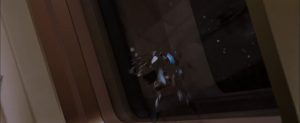
The vase Aurora throws at the window
- There are further glitches with the Avalon‘s computer systems and Aurora finds that Jim has dug up part of the main Concourse and has planted an actual tree from the stocks of plants and animals the Avalon carries (Tyldum, 2016, 01:11:10). Only a few seconds later we watch Jim in an elevator and it breaks down. A food delivery machine in the main Canteen sprays cereal all over the floor at Aurora’s feet (Tyldum, 2016, 01:11:19) and then suddenly Jim and Aurora, well away from each other, hear a new, human voice on the Avalon (Tyldum, 2016, 01:11:57) asking in stern tones who has planted a tree in ‘my ship’.
- Wearing his blue uniform with gold piping Deck Chief Mancuso meets Jim and Aurora and they use his control wristband to enter the main Control Room and Flight Deck (Tyldum, 2016, 01:13:15). The Chief staggers , but thinks this is just hibernation sickness. The Chief is told by Aurora that Jim awakened her from stasis and he sees the open pod. The Chief gives his view on this by saying that what Jim did was not right but “the drowning man will always try to drag someone down with him. It ain’t right, but the man’s drowning.” Then he collapses. He spits blood and crawls off to rest (Tyldum, 2016, 01:17:46).
- In an extraordinary scene, Aurora swims in the Universe Pool and Jim heads to bed to sleep. The scene cuts between Jim asleep in bed and Aurora swimming and the music speeds up and adds high, worried notes from a synthesizer. At 01:18:17 the scene cuts to the Avalon outside in space with the seed arms turning. They simply slow and stop and the main flare of the engine goes dark. A warning sign is displayed on the Control Room holographic display, saying “Gravity Loss” with a Red Circle (Tyldum, 2016, 01:18:30). The water rises from the pool with Aurora caught in a great teardrop within. These are very good effects and deeply worrying.
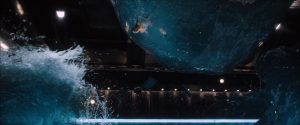
Aurora caught in the water globule during no gravity
- Jim slips out of his sheets and drifts up into the air in his cabin. Everything else drifts as well. Even the Chief’s arms drift up. At 01:18:47 the music builds further and Aurora cannot breathe. We hear her trying not to breathe out as she realises she is trapped in the great, floating ball of water. She manages a gulp of air upside down (Tyldum, 2016, 01:18:55) with chairs and tables floating in the air nearby. At 01:19:15 Jim awakens in his room in mid-air and sees things floating nearby. Aurora gives up struggling in her bubble of water in the pool room. A display in the control room lights up and goes red saying Gravity Drive and we see the outside of the Avalon. The fusion drive is back on and the sycamore seed arms start turning again. Jim falls badly in his room, hitting the first floor then dropping down to the next. The water collapses back into the pool at 01:19:44 with Aurora inert inside. She emerges, gasping for air at 01:19:53. They run to find the Chief in his cabin and they awaken him and head to the Control Room. The Control Room display models a prediction of catastrophic failure for the Avalon and Aurora says, “So, we’re stranded … on a sinking ship.” (Tyldum, 2016, 01:21:25)
- The Chief collapses and is carried by Jim and Aurora to the Autodoc, a medical device with amazing capabilities. The Autodoc says the Chief has 612 failures but will not give a prognosis. The Stoic chief overrides this with his wristband authority and the code 2317 and the Autodoc informs all three of them that the Chief will only live another hour or so. (Tyldum, 2016, 01:22:03)
- There are many more problems with the Avalon and Jim and Aurora find the dying Chief in the virtual display chamber. He gives the ID bracelet to Jim and asks Aurora how he looks and she says “You look magnificent” and he replies “ladies love the uniform” or some rubbish and then he dies (Tyldum, 2016, 01:23:56).
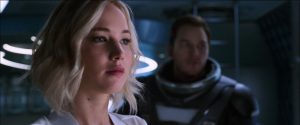
Aurora with Jim in space armor watching the Chief go
- Jim and Aurora run back to Engineering with gravity failing (Tyldum, 2016, 01:25:35) in interesting ways (see notes on problems with the Science of the Avalon, below) and they observe Android Arthur also failing and he slices open his synthetic face. Searching for the error they enter the Power Plant and find a hull breach that sucks out the air and nearly Aurora just before Jim seals one hole with some clever hard-setting foam. They now understand that a very small part of the giant meteroid has breached the Avalon and they trace its passage back to the Reactor Control Computer (Tyldum, 2016, 01:28:31) room. This room enables operators to see plasma swirling about in a cylindrical space, becoming more energetic and starting to damage the transparent material on the room (Tyldum, 2016, 01:29:38). Jim finds a replacement for one crucial panel in the stores and notes that most spaceships have multiple redundancies for critical elements.
- At 01:29:38 the glass starts to crack with the plasma swirling faster and wilder and the music likewise. Jim and Aurora restore some control but the reactor does not vent and instead requests a manual override (Tyldum, 2016, 01:29:51). The outer door is non-responsive and Jim explains what this means to Aurora
- At 01:29:38 the glass starts to crack with the plasma swirling faster and wilder and the music likewise.
- Jim and Aurora restore control but the reactor does not vent and instead requests a manual override at 01:29:51. The outer door is non-responsive and Jim explains what this means to Aurora. Jim grabs a space suit and explains he will open the door from outside. She asks “What happens when the door opens?” and Jim burns a door off a cupboard in the spacesuit supply room and says “heat shield”. Aurora looks worried and has disheveled hair.
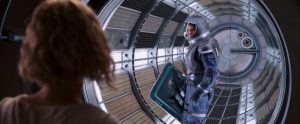
Aurora watches Jim in space suit and shield leaving for the final battle
- Jim gives Aurora the command bracelet (Tyldum, 2016, 01:30:58). She helps dress Jim in his space suit and he takes the shield with him, saying “I better go”. She says, “Jim, Jim come back to me,” as he leaves to go outside. “I can’t live on the ship without you” she says.
- Jim walks through the access tunnel outside and flies/crawls around to find the vent port. Aurora is impaled in the arm by a flying bolt from a metal plate in the control room. The machines of the control room room are so hot that Aurora tears off a layer of clothing to move a lever.
- The temperature is critical (Tyldum, 2016, 01:33:01) and the next cut is Jim as he floats through an access pipe to vent the reactor. After some experimentation with the broken lever in the venting pipe he realises he has to stay to keep the door open and she says to “get out of there” (Tyndum, 2016, 01:33:36). He tells her to “vent the reactor” and he argues with her and she says to come back in and he is noble and says “There are five thousand other people on this ship. We have to do this. Do it!” (Tyldum, 2016, 01:33:36). She pulls the lever and the plasma flies straight up through the now open venting pipe and past Jim, who holds the shield to protect himself but even so his visor is cracked and starts to melt. Jim groans and holds his place and his suit starts to burn up. He is expelled from the access tube (Tyldum, 2016, 01:35:59) in a ball of fireand his tether breaks. He is flying towards the Avalon’s engines where they are restarting in a ring of blue fire. As he draws near he throws the shield towards the engine blast and is propelled back towards the habitat and command areas (Tyldum, 2016, 01:36:20). Jim has a tiny hole in his suit and the computer says “Suit pressure dropping”. Oxygen level is critical for Jim and his faceplate is cracking and icing-over. He says “Aurora, I’m sorry for everything. I wish I met you in 90 years. I would have built you a house. I’d have read your book.” (Tyldum, 2016, 01:37:41)

Jim holding his shield against the plasma venting
- Aurora runs to the space suit and heads out to collect Jim. Given the rotation of the habitat areas and Jim’s recent flights from the explosion, Aurora makes an excellent guess and leaps from the ship to intercept Jim but falls just short. Then, she sees the end of his broken tether moving past and grabs that at the last moment (Tyldum, 2016, 01:38:54).
- Aurora manhandles Jim frozen and dead into the Autodoc but the Autodoc pronounces Jim dead (Tyldum, 2016, 01:38:54). The she remembers the code for an override (ID 2317) and overrides the multiple procedures. Lots of robotic things happen to Jim and she believes he is now unable to be revived. She kisses him and then, he breathes out a sigh of air. They kiss as lovers again (Tyldum, 2016, 01:41:48).
- The next two scenes show Jim playing with the Autodoc and looking thoughful, then there is a simple ceremony and the Chief is vented out through the spacewalk access by Jim (Tyldum, 2016, 01:41:17). Aurora is in a white shirt with very white hair watching the Chief expelled into the starry space and Jim stands beside her in the silver armor of the spacesuit.
- Jim tells Aurora is a way to return to stasis. She can be kept asleep for the next 90 years but Aurora says “But there’s only one Autodoc” (Tyldum, 2016, 01:43:43). The next rapid cut is Aurora thinking about her possible salvation to return to stasis and there are a series of rapid cuts to show the ship running properly, now that the problem is solved. Jim sits at the bar with Arthur, who has had his head repaired. Jim smiles at Arthur and Aurora turns up in a red dress. Jim gives Aurora a silver ring he made (Tyldum, 2016, 01:45:42) and there is a rapid cut to them both in swimming suits in the Universe Pool looking out at the stars and they both say “Hell of a life”.
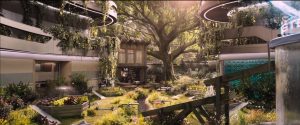
The Avalon’s green makeover as Jim and Aurora create a little paradise
- The screen is captioned with Homestead II, 85 years later. The crew walks out onto the Grand Concourse and the audience sees the house Jim made for Aurora, the robots tending and taking fruit from the garden, chickens walking in grass and flowers. The tree Jim planted is now very large. There are even two birds flying in the inside of the done looking up at the stars and Aurora says from her book “and we made a life, a beautiful life, together”. (Tyldum, 2016)
Themes motifs and mise-en-scene
Themes in the film:
A theme in a film is similar to a theme in a poem, short story or novel and is described in a simple form as, “A film’s theme is what the film is essentially about. The theme of the film is conveyed through its narrative, the behaviour of the characters and the style of the film.” (Caldwell, 2014, p180). Some themes are described in the quotes section, below, but the audience can always find their own themes and these can be defended with evidence from the visual text.
Passengers (Tyldum, 2016) seems to combine elements of the Romance genre with SF. Unusually, the romantic elements revolve around the crucial moral choice the protagonist, Jim, takes when he awakens Aurora from her stasis pod through a sort of desire that may have been closer to mania caused by loneliness, rather than love. This leads to a major theme that asks the audience if humans must have human companionship, or life is not worth living. Other, more obvious themes include ‘true love conquers all’, and ‘love means forgiveness’. There are several, other platitudinous themes that can also be identified in the film and also a few very Science Fictional themes:
- computers/machines are fallible and humans can not surrender their fate to machines, and
- travels through space are risky even in the best spaceship.
Motifs:
Just as in a novel or shorter narrative a motif is a “distinctive recurrent element” (Chandler & Munday, 2016). Some motifs are found frequently in the genre of Science Fiction (SF), such as the protagonists search for answers, a planet, a person or a place in deepest space. In the sub-genre of the Generation Spaceship within SF some motifs are found across many texts, such as the vast array of stars seen through a visor or a transparent shell. The repetition of the motif leads it to “acquire a ‘ symbolic ’ significance” (Chandler & Munday, 2016). For a visual text such as a film, Caldwell (2014, p.18) describes a motif as “anything that is used repeatedly in a film to define or explain a character or to suggest a theme. Sounds or musical phrases can also be motifs.”
Passengers (Tyldum, 2016) uses several recurrent elements and just one is the use of the small, cleaning robots. Initially, the starfish-vacuums are clever, coordinated and efficient. Then, as the central computer systems fail, the robots fail. They are uniform, bland grey and identical and their programming is malfunctioning. This relates directly to the major theme of the foolhardy trust in machines that nearly destroys the Avalon.
Music in Passengers (Tyldum, 2016) is also important with the songs used relating to the thoughts and feelings of the protaganist, Jim. The settings of the Deco bar, the platinum ornaments Jim crafts are also important motifs that affirm the longevity of romantic love, even in the Interstellar Colonisation Age.
Mise-en-scene and tropes:
For analysis of films, the French term ‘mise-en-scene’ is often used. Mise-en-scene are “all the elements within the frame of the film” (Caldwell, 2014, p.133) such as setting, lighting, costume, acting style and Computer Generated Imagery (CGI).
A trope in a novel or shorter narrative is a figure of speech “especially one that uses words in senses beyond their literal meanings” (Baldick, 2015). Tropes in formal argument could be metaphors or rhetorical questions but in the genre of Science Fiction they are a “familiar, metaphorical, and/or rhetorical figure of speech or way of telling a story” (Harcup, 2014). Some tropes of SF film narratives are devices, such as space shuttles, fusion engines and virtual reality displays that shortcut the process of explaining what these actually do or how they work. Instead, the viewers accept them as part of the SF furniture and move on with the narrative itself, unless the trope is a vital part of the story.
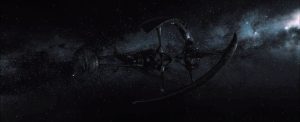
The Avalon with engines and lights gone
In Passengers (Tyldum, 2016) there is a great deal to discuss for mise-en-scene. One of these elements would have to be the CGI of the scenes where Jim holds up his shield to avert the venting plasma from the nuclear core that powers the Avalon. Individual stills show the director’s decision to mimic a valiant knight in silver armour holding steadfast against a dragon’s fiery breath.
Tropes in Passengers (Tyldum, 2016) abound and are all clever, well designed and useful, such as the Control Computer interface, the very odd fusion reactor chamber where the operators can see the plasma swirling about, and the virtual reality basketball and dance games, another simulation to pass the time for those on GS craft.
Discussions of the film:
Reviews of Passengers (Tyldum, 2016) were excited initially but soon after the film’s release became less complimentary. There was qualified praise for the main characters of Aurora and Jim played by their very popular actors, with less reserved praise for Michael Sheen’s largely deadpan comic work as Android Arthur. While the reviews since the release of the 2016 film are interesting to follow, they are not of major concern for the GS Project, except where the narrative relates to themes and tropes within this study. However, as this major film release is one of only a few full-length films based on the journey of a spaceship travelling at less than light speed to a habitable planet, it is important to discuss Passengers here, starting with one of the main objections to the Passengers (Tyldum, 2016) narrative, the central element of Jim awakening Aurora from her stasis sleep and condemning her to death on-board the Avalon.
Amongst some reviews weaker reviews Gilbey (2016) stated that Passengers (Tyldum, 2016) was a mistake and he noted Chilton’s (2016) review in Metro that found a source for the film in an early SF comic book, ’50 Girls 50′ (Williamson, 1953). Chilton (2016) spoke of the unexpected twist at the end of the comic book as the woman awakened from her stasis pod turned the stun gun on the male crewman who revived her, as she hoped to awaken a different man, whom she secretly wanted. In the comic book half the crew are women in stasis and an unscrupulous traveler organised to revive from stasis and sleep with one girl after another. His awful plan meets the deceitful Wendy but her treachery is not rewarded as he has already turned off all the other males’ stasis pod and they are all dead.
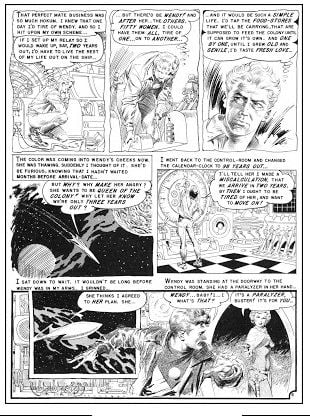
A page from Williamson’s ’50 Girls 50′
Some parts of the two narratives are quite similar. In ’50 Girls 50′ (Williamson, 1953) the protagonist complains that, “I’ve been thawed for six months, going crazy all by myself. My relay failed, that’s what happened to yours too.” He also breaks the bad news that the stasis pods can only turn on once, “The quick-freeze process can only work once. The human body can stand only one freeze and one thaw”. And when she learns of his dreadful act of awakening her she says, “”You …you thawed me! You did it on purpose. You wanted company. You wanted …Oh, God … and now you’re bored.” (Williamson, 1953). While the characters of ’50 Girls 50′ are both tough people with selfish and unscrupulous desires, the romantic couple of Passengers follow a more conventional pattern of falling in love and courtship.
For Gilbey (2016), the developing romance between Aurora and Jim was painful. He writes in his review for New Statesman that as Aurora “starts to fall for Jim, she writes: ‘He makes me feel my life isn’t over. Like it’s only beginning.’ Later that night, she got to thinking that this was ‘some of the best work I’ve ever done.’ I’d love to hear the worst.” (Gilbey, 2016) He also points out that while in many films when a couple finally falls into bed the film cliche and joke metaphor of cutting to a train heading into a tunnel is replaced as “the first time the couple fall into one another’s arms in bed to an exterior shot of the spaceship ploughing through the galaxy, its extended phallic nosecone dragging it into a black hole of innuendo. It’s really a space-age version of the old train-going-into-the-tunnel gag.” (Gilbey, 2016)
STEM aspects of Passengers
Writing for Voice of America, Lee (2016) pays more attention to the science of the Avalon’s 120 year journey, noting the way the outer habitats shaped like sycamore seed husks rotate. It was clear to Lee that “some real science underpins many of its ideas” and quotes engineer John Bradford explaining the notation of artificial gravity by the spinning habitat modules where the rotation ” creates artificial gravity, which can mitigate some of the damaging effects of extended time in a microgravity environment, including “bone demineralization and muscle atrophy,” Bradford said. “Having this artificial gravity solves those problems, and rotating it is the best way to do it.” (Lee, 2016) The vital detail of the stasis pods is also discussed with Lee quoting SpaceWorks Enterprises who claimed that such a state of stasis could be produced for a two week stretch ” within current medical technology”. The company published a paper that could assist the first missions to Mars with the notion of two-week stasis periods for the crew on the relatively short distance to that planet.
Lee (2016) also commented on the need for space vehicles to increase their speed for journeys to other star systems as using the current technologies (such as the Juno spacecrafts 240,000 kph) orbiting Jupiter, the technology must “make that leap …to achieve close to light-speed travel” or even the closest Earth-sized exoplanet, like Proxima b, would take “tens of thousands of years to reach” (Lee, 2016).
The science of Passengers (Tyldum, 2016) was also explored by Davies (2017), writing for the journal Principium. Working closely with the designs for the Avalon by its CGI makers, Davies notes that the craft is approximately half a kilometre in diameter. Jim and Aurora move normally when the artificial gravity works, though the centripetal force would mean that there would be 10% less gravity at the top of Jim’s head than at his feet. Davies (2017) also proved that when Aurora ran the length of the Avalon and then back again she would be faster in one direction than the other. Davies notes that “there are also some weird effects of rotation-based artificial gravity” such that if you, “drop something it doesn’t fall in a straight line, Coriolis forces will push you sideways if you move in any direction except parallel to the spin axis” (Davies, 2017).
Davies points out several problems with the film based on the science they were modeling in Passengers (Tyldum, 2016). When Aurora throws a vase at the window it breaks and drops as if it were Earth gravity, and the same occurs in the excellent scene where Aurora nearly dies in the globule of gravity-free swimming pool water. When the gravity returns, the water drops straight down in place, though it should not, according to Davies (2017).
Davies could not understand how the artificial gravity could suddenly be lost and as suddenly return, when the habitats resumed spinning. He notes “In a matter of a second or two a spacecraft half a kilometer in diameter goes from rotating at about 1- 5 RPM to virtually zero RPM. That’s a lot of angular momentum to dump!” (Davies, 2017) And when the fusion reactor cuts in again and the sycamore winged habitats start rotating again gravity is restored immediately. He notes, “Well, if we believe one implausible thing (gravity removed in less than a second) we have to believe the other (gravity restored in less than a second).” (Lee, 2017)
There are tools available on the internet that Lee (2016) points out enable calculations to be made for film depictions of GS craft. One of these is ‘SpinCalc‘ that can work out the rotation rate necessary to produce 1G of artificial gravity and will allow the dimensions of the spacecraft to be discovered. From a scientific point of view Davies (2017) and this writer were both surprised that there was only one Autodoc on the Avalon, for a craft that had a large bar, recreation areas and was designed to cope with 5000 passengers. In one scene near the conclusion of the film Aurora also seems surprised and says with disbelief, “Only one Autodoc” (Tyldum, 2016, 01:43:43). Finally, like many viewers, the use of a simple metal door to stop the full force of the venting fusion plasma seemed wrong to Lee (2016), but certainly produced some memorable CGI scenes.
There were no such scenes with the earlier script for Passengers (Tyldum, 2016) as the reset of the main Avalon computer made the craft believe it docked and it vents its stasis pods, dumping 5000 passengers into space. This means thaat they are the only ones left on the ship and when the craft eventually comes into Homestead II the small crowd of people coming out of the ship are Jim and Aurora’s descendants. (Leadbeater, 2016).
These earlier versions of the script avoided the last, Ark-like revivification of the Main Concourse of the Avalon as seen in the version released (Tyldum, 2016) but left the audience wondering who buried the survivor of Jim and Aurora and where the graves might be in the last scene.

The Avalon’s green makeover as Jim and Aurora create a little paradise
Relevance to the focus questions
The focus questions for the GS Project are:
- What is worth holding onto over the generations?
- What should be discarded for the voyage? and
- Can life be sustained in the GS …or on Earth?
- Passengers (Tyldum, 2016) is an unusual GS narrative because of its concern for the central moral point of Jim’s awakening of Aurora from her stasis pod because of his infatuation with her and his growing depression from loneliness on the Avalon. The moral point that it was wrong for Jim to awaken Aurora is seen clearly by many reviewers but this unethical act was made more palatable for the audience because of the ongoing problems for the Avalon due to the meteoroid breach of the ship and into the nuclear core area.
- The audience is invited by the narrative to mitigate Jim’s desperate act for several reasons. The first is the main element of the film that follows the growing friendship, then romantic love of Aurora for Jim. In an earlier recording made by Aurora closest friend the audience learns that Aurora has trouble committing to relationships and we see Jim’s relationship with her changes this to a strong love and dependency, seen when she tells Jim he must come back as she can not live without him.
- Another mitigating factor for Jim’s wrong act is the malfunctioning of the Chief’s stasis pod. The Chief, with his control wrist-band, are absolutely necessary to stop the destruction of the Avalon by the nuclear core spiraling out of control. The Chief is killed by a faulty revival process but he does enough to at least give a chance for Jim and Aurora to save the thousands of lives of those onboard. This awakening of the doomed Chief works in two ways, to tell the audience that Jim would not have been alone for much longer, anyway, but also necessitating Jim to collaborate with the estranged Aurora to save thousands of lives. If Jim had not awakened Aurora then all lives would have been lost because saving the Avalon required two people working together, with the Chief’s controlling access.
- Jim’s suffering through violence at Aurora’s hands, her total rejection of him for a long period, and his bravery in risking his life in venting the plasma shows the use of the themes of suffering and redemption in Passengers (Tyldum, 2016). Jim dies saving not only Aurora but the entire crew and passengers on the Avalon. He is revived by Aurora and very clever futuristic technology and this allows him to be portrayed as redeemed and born-again. He has atoned for his evil and can now be accepted by Aurora and the audience, though it is clear from reviews that this was still not enough for many.
- Finally, Aurora is desperate to save Jim’s life after the venting of the nuclear core plasma and risks her own life to do so. Her love for him, and perhaps her own fear of loneliness, conquers the anger she feels when Android Arthur lets slip the truth. Her final words read as a voice-over, diegetic narrator (Caldwell, 2014, p.130) show that she was happy with Jim making a home for themselves on the Avalon and turning the Grand Concourse into a little corner of Eden. It is clear through this final testament that Aurora never uses the Autodoc to slip back to stasis and prefers to live and die with Jim. This also mitigates against Jim’s wrong-doing.
- In terms of the focus questions, it is clear from the last scenes of Passengers (Tyldum, 2016) that the Avalon can become a sort of beautiful Ark with a self-sustaining garden that is “all watched over by machines of loving grace” (Brautigan, 1967). It might be argued that romantic love, bravery and self-sacrifice are seen as worth preserving in Passengers (Tyldum, 2016) with a warning that over-reliance on computers should be abandoned by humans journeying through space.
Resource list
Brautigan, R. (1967) ‘All Watched over by Machines of Loving Grace’. In All Watched Over by Machines of Loving Grace. USA: Communication Company.
Caldwell, T. (2014). Film Analysis Handbook. Cheltenham, Victoria: Insight Publications.
Chilton, L. (2016) Jennifer Lawrence and Chris Pratt get up close and personal in new Passengers trailer. Metro.co.uk. Published 20 September 2016. Accessed 2 January 2017 from http://metro.co.uk/2016/09/20/jennifer-lawrence-and-chris-pratt-get-up-close-and-personal-in-new-passengers-teaser-6139446/
Davies, J.I. (2017) Passengers: Magnificent but Flawed. Is it the first true interstellar film? In Principium. Issue 16, February 2017, pages 18-23. Accessed 14 February 2017 from
http://i4is.org/wp-content/uploads/2017/02/Principium_16_Feb_2017.pdf
Gilbey, R. (16 December, 2016) Passengers is Jennifer Lawrence’s dumbest film choice yet. Film Section. New Statesmen. Accessed 7 March 2017 from http://www.newstatesman.com/culture/film/2016/12/passengers-jennifer-lawrences-dumbest-film-choice-yet
Leadbeater, A. (2016). Passengers: Differences Between Original Script’s Ending & Final Film. Screenrant. Accessed 7 March 2017 from http://screenrant.com/passengers-original-script-ending-film/
Lee, E. (December 21, 2016). Scientists Decipher Fact From Fantasy in Movie ‘Passengers’. Silicon Valley and Technology. VOANews. Voice of America. Accessed 7 March, 2017 from <http://www.voanews.com/a/scientists-decipher-fact-from-fantasy-in-movie-passengers/3644841.html> VOA: Washington, USA.
Lyall, S. (December 31, 2016). Passengers vs ’50 Girls 50′. Simon Lyall’s Blog. Accessed 150717 from https://blog.darkmere.gen.nz/2016/12/passengers-vs-50-girls-50/
Praska, J. (June 19, 2013) Somnio: New, Independent SciFi Project from Travis Milloy. In The Continuing Voyage. Accessed 030715 from https://thecontinuingvoyage.com/2013/06/19/somnio-new-independent-scifi-project-from-travis-milloy/.
Tyldum, M. (Director). (2016). Passengers. Written by Jon Spaiths. USA: Columbia Pictures.
Williamson, A. (July-August, 1953) 50 Girls 50. In Weird Science. Number 20. Script by Bill Gaines and Al Feldstein. USA: EC An Entertaining Comic.


